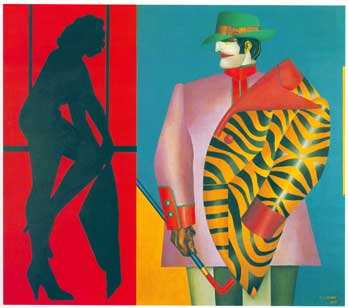Richard Lindner
Richard Lindner (Hamburg 1901 – New York 1978) studied art at the Arts and Crafts School in Nuremberg, Germany. After spending some time in Paris, in 1941 he moved to New York, where he worked as a graphic designer and illustrator for publications such as Vogue, Fortune and Harper’s Bazaar. In 1952 he agreed to teach graphic expression at the Pratt Institute in Brooklyn, where he remained until 1965. In his paintings Lindner gradually abandoned European themes and became particularly interested in the American world, from which he extracted strange, caustic allegories. His stylised compositions with their bright colours vividly recall comic strips, presenting robust characters—adult children, prostitutes, gangsters, policemen—from the corrupt world of the city. In his choice of the human figure as a vehicle of symbolic expression, Lindner belongs to a distinguished group of post-war artists, including Balthus and Bacon, who remained apart from any school or movement. Considered in the sixties as a forerunner of Pop Art, Lindner always insisted that his work was that of an intruder. In an interview he declared that he saw himself as a man born between two generations, Dada and the more recent generation of American artists. The identification of him as a displaced artist provides the key to his figurative symbolism. However, through his irony, style and themes inspired by popular culture and advertising he remains linked to the art of Europe between the two World Wars, as can be seen in the powerful element of eroticism and social criticism in his work. Werner Spies, director of the Centre Georges Pompidou in Paris and author of the text in the catalogue, points out that the exhibition enables us to see the work of a significant solitary figure. Lindner paints a world of yesteryear. His way of seeing is embedded in the present with the weary awareness of a man who can only live in the present moment by maintaining history behind it. Europeans seek an American element in their paintings; Americans look for a European element. Lindner made conscious use of the American setting, succumbing to its fascination but not renouncing the background of his European condition. The exhibition was organised by the Fundación Juan March and the IVAM, Centre Julio González.



